
Just about a year ago, Steven and I were vacationing in Phoenix when we decided to head downtown to tour Arizona's state capitol as we wanted to see as many capitol buildings when overseas travel came to a screeching halt when Covid took over the world. Little did we realize that January 6th, 2021, was a day that would change the US forever when insurrectionists stormed the US Capitol in DC. When we arrived at the statehouse in Phoenix last January 6th, it was immediately apparent that no touring could take place that day because of the vast number of armed protesters who were occupying the entire Capitol plaza. Rarely had Steven and I felt so out of place and uncomfortable as we were surrounded by people wanting Trump back in office and Biden booted as the newly elected President.


Since we couldn't tour the capitol last year, we returned and hoped that the Capitol Museum would again be open to tourists. In the previous 18 months or so, Steven and I figured we had visited about 30 state capitals. On the grounds of each capitol building were various memorials but absolutely none were the scope of the enormous Memorial Plaza in Phoenix.

The Vietnam Memorial honored the veterans.
A few feet away were two monuments proclaiming the Bill of Rights which comprised the first ten amendments to the US Constitution. When the third and final document of the Founding Fathers was ratified in 1791, it completed the framework begun with the Declaration of Independence in 1776.
After seeing the Navajo Code Talker in Gallup, New Mexico en route to Phoenix, we recognized this one outside the state capitol. The language code used by the young members of the US Marine Corps in the Pacific Theater during WW II is the only unbreakable code in modern military history.
I think this Desert Storm Memorial must be the most colorful memorial we'd ever seen!
I was surprised to learn that Arizona had a big enough Armenian community to warrant an Armenian Martyrs' Memorial.
Ever since Covid began, Steven and I have made a point of touring as many of the state capitals as we could. Never had any other capitol complex we'd seen comprised a Gold Star Families Memorial Monument. It was a tribute to Gold Star families and relatives who sacrificed a fallen loved one who died while serving in a time of conflict. The Gold Star term became known in January 2005 by individuals who lost family members in the Iraq War.
The reverse of the monument:
This Korean Bell was dedicated to the Arizonas who gave their lives in the Korean War.
The mast of the USS Arizona Signal honored the crew of the battleship that sunk at Pearl Harbor on December 7th, 1941.
After seeing so many WW II memorials throughout the country, I found Phoenix's Guns to Salute the Fallen particularly moving. The 14" gun barrel from the USS Arizona and a 16" barrel from the USS Missouri were the bookends to the memorial. Between the barrels were steel pillars in the shape of a battleship hull that honored the 1,902 Arizona men and women from various branches of the military who died in the war.
From the center flagpole looking west to the first marker was 608 feet which represented the length of the USS Arizona from bow to stern. The 887 feet distance to the second marker represented the length of the USS Missouri from bow to stern.
Names of the fallen were engraved on small plaques that reminded me of dog tags.
The Arizona Fallen Firefighters Memorial was among the largest of all those we'd seen. The purpose of the memorial was not to mourn but to remember.
I wasn't sure we'd ever seen a 9/11 Memorial at any other state capital so that's why it was so surprising seeing one in Phoenix, so far from any of the sites associated with that horrific day. One of the most moving memorials we'd seen involved the sun showing through openings from 10 until 3 each day that revealed descriptions of decisions and reactions on September 11th, 2001. The memorial's combination of letters and shadows represented the approximate number of people killed in the attacks.
The memory of that terrible day literally cast a shadow from New York City, Washington, DC, and Shanksville, PA, to the people here in Phoenix.
I think Steven and I were sort of relieved when we came across the Peace Officers' Memorial as it was finally the last one in the Capitol complex. We were soon to see many monuments, though, on the memorial plaza!
Father Albert Braun was an army chaplain in both world wars and was a prisoner of war in the Philipines. Beginning in 1949, the young missionary and teacher taught indigenous tribes in New Mexico and Arizona and later built a church for Hispanics in central Phoenix.
The Jewish War Veterans of the USA Memorial:
The monument honored Arizona's Pioneer Women who came to the state from the East and the South before 1875. From this group, came the first schoolteachers and the publisher of the first newspaper.
If we hadn't already seen enough monuments and memorials, there was also the Arizona Workers Memorial entitled El Pasaje that honored the state's earliest workers.
In front of the capitol was the Centennial Cactus that commemorated the state's 100 years of statehood when it was admitted to the Union in 1912.
Unlike any other capital city we'd made a point of visiting recently, there was no currently used capitol building in Arizona's capital city that could be toured. All that was available was the four-story Arizona Capitol Museum that opened in 1901 as the territorial capital.
The statue of the miner represented the state's major copper industry and was part of an extensive silver collection on the USS Arizona. I read that battleships were often used during peacetime as floating embassies to entertain foreign dignitaries and show the country's military strength.
In a large room upstairs the Arizona Railroad Historical Society was in the middle of a five-year project building a massive railroad exhibit that depicted the state prior to the construction of the interstate system which appeared in the 1950s. One of the volunteer railroad enthusiasts told us that was the golden era of railroading when steam and diesel power moved people and products across the state and beyond.
Over 2,000 miles of railroad track were part of the display which will represent Arizona in its entirety when complete. For any railroad buff, this place must have been sheer heaven. We weren't but were still stupefied by the level of detail and historical accuracy.
The guide mentioned the original five C's of Arizona: copper, cattle, citrus, cotton, and climate. Here were the cattle. Other parts of the display represented the other C's.
The state's citrus industry was represented in these trees.
The railroad was a true labor of love for all the volunteers as the state only provided the room, light, and air conditioning. The guide told us that one million dollars in man-hours had already been used to construct what we saw. It would be fun to return to the capitol museum when we are planning to be in Phoenix next February to see what further progress has been made!
Palm trees were fashioned from pipe cleaners rolled in a paper towel tube and painted brown!
What incredible attention to detail including cave dwellings, tiny, tiny animals, the family of deer, and buildings depicted in the city of Tucson that were still present today.
The picture showed what this part of the railroad would look like when completed in another two years.
Though originally there were five Cs representing the state, cactus and canyon had been added. Among the saguaro were a fox and a few animal skeletons to lend reality to what would normally be found.
The image of the state capitol was as it appeared in 1958.
Buildings and the bridge as they looked like in the 1950s in the western Arizona city of Yuma:
Hopefully, when we return next year, we'll see the South Rim of the Grand Canyon with Grand Canyon Village and Bright Angel Lodge being at eye level. On the opposite wall will be a mural of the North Face of the canyon. Something to look forward to!
Arizona's state flag was adopted by the legislature in 1917 after being created for a rifle guards competition because the only team that didn't have an emblem was from Arizona. The 13 rays at the top represented the original colonies and the setting sun; the copper star in the center pertained to the state's robust copper mining industry; the blue was the same as the Liberty Blue in the US flag.
The 6.8-feet-high and 10.25-feet wide Lego flag of Arizona was comprised of 113,998 blocks, which was equal to the state's square mileage. The Lego company in Denmark made the custom dark red and blue colors just for the Arizona flag.
The photo showed members of the House of Representatives of the First State Legislature in 1913 in the House chamber.
And as it is today:
In 1889, the 15th Territorial legislature permanently relocated the Capitol from Prescott to Phoenix. The original concept for the Capitol was based on the design for Mississippi's Capitol but it was too costly and opulent for the Territory. A more modest version was approved that fit within the Territory's budget and vision.
After the chosen site was donated by two men in exchange for a single dollar, the ground was broken in 1899.
Requirements stipulated that the Capitol be constructed as much as possible from materials found in Arizona. The building was made with malapai rock for the foundation, granite on the first floor, and tuff stone for the remaining floors. The lumber came from five states and territories.
The large tile mosaic of the State Seal we'd seen as we entered the museum was designed by artists living in Ohio who had never seen the Arizona State Seal before. The official design called for a cow beside the miner but it was missing in the final mosaic!
When famous architect and Arizona resident Frank Lloyd Wright learned of the state's plan to expand the Capitol building in 1957, he submitted an unsolicited proposal that would have moved the Capitol to the Phoenix suburb of Tempe. His design, however, far exceeded the budget and also violated Arizona's Constitution.
I was very disappointed that we couldn't tour the 'real' or current Capitol in Phoenix instead of the Capitol Museum with its artifacts and exhibits. I would love to have known why the Capitol itself was closed to the public, unlike the other capitols we'd visited.
On either side of the Capitol Museum were the architecturally boring and identical House of Representatives and Senate.
Far more pleasing to our eye were this building and the Phoenix Public Library.
Adjacent to the library was a large park and innovative playground paid for by the Fiesta Bowl organization, sponsors of the annual college football game.
For anyone interested in touring state capitols, I'd not recommend going out of your way to stop at Arizona's as the current capitol isn't open and the Capitol Museum held little appeal except for the one-of-a-kind state Railroad Museum.
Next post: Deer Valley Petroglyph Preserve outside of Phoenix.
Posted on March 19th, 2022, from warm and sunny Denver just a few days before we hit the road again for even hotter Hawaii for three weeks. It'll be great getting away from the weekly snowstorms we've faced since returning from Phoenix.






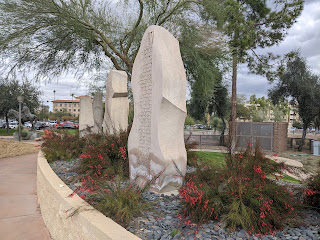
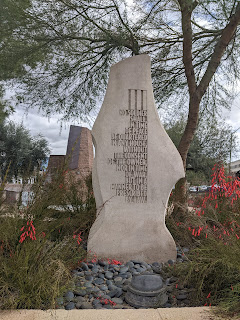













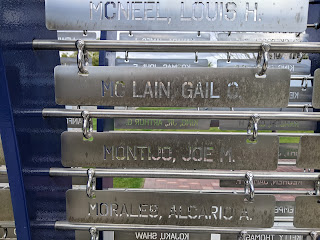




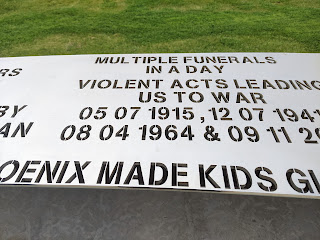





























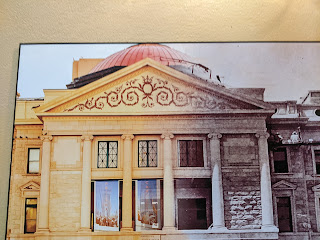












No comments:
Post a Comment